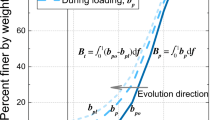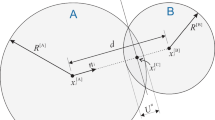Abstract
The motion forms (deformation) of the sliding soil along the slope include inviscid particle flow, viscous particle flow, and mass sliding. The motion forms were mainly influenced by the mechanical properties of the viscous mud medium filling. The effect of the medium filling on the motion forms of the sliding soil is worth discussing. The sliding soil can be seen as the mixture which is composed of the medium filling and coarse particles. The Chengdu clay with different moisture contents were selected as the medium filling. Their mechanical parameters were experimentally measured for simulating the moving process of the sliding soil. Different motion forms of the sliding soil were numerical simulated based on PFC3D by changing the specific mechanical parameters. The mechanical parameters of the Chengdu clay are experimentally determined. The numerical results show that with the moisture content of the filling slurry medium in the range of >302%, 101%~182%, and <80%, the motion form of the sliding soil belongs to the inviscid particles flow (similar with the sliding sand), viscous particles flow (seen as the viscous flows); and mass sliding (seen as the block sliding along the slope surface), respectively.
Similar content being viewed by others
References
Cundall PA (1971) A Computer model for simulating progressive large scale movements in blocky rock systems. Proceedings of the Symposium of the International Society of Rock Mechanics. Nancy, France. International Society of Rock mechanics: 2-8.
Cundall PA (1988) Formulation of a three-dimensional distinct element model-part I scheme to detect and represent contacts in system composed of many polyhedral blocks. International Journal of Rock Mechanics and Mining Sciences & Geomechanics Abstracts 25(3): 107–116. DOI: 10.1016/0148-9062(88)92293-0
Cundall PA, Strack ODL (1979) A discrete numerical model for granular assemblies. Geotechnique 29: 47–65.
Dong XB, Wang LS (2000) Kinematic features of landslide after slope failure. Journal of Geological Hazards and Environment Preservation 3(11): 31–37. (In Chinese)
GB/T 50123-1999(2007) Standart for soil test method. China Architecture & Building Press. p 14. (In Chinese)
He KQ (1991) Debris flow-a new geological disaster. Hydrogeology and Engineering Geology 18(5): 21–23. (In Chinese)
Hu HT, Liu YJ, Xing AG (2003) Hydrodynamics theory study of high-speed long distance landslide. Southwest Jiaotong University Press, Chengdu, China.
Itasca Consulting Group, Inc. (2006) PFC3D users manual. Minneapolis, USA: Itasca Consulting Group, Inc.
Ji XJ, Ou GQ, Yang S, et al. (2012) Research status and prospect of moving process of landslip-collapse soil along slope. Journal of Mountain Science 30(3):361–368. (In Chinese)
Ji XJ, Liang Y, Ou GQ, et al. (2015) Numerical simulation and verification about viscous debris motion process on slope. Rock and Soil Mechanics 36(8):2402–2408. (In Chinese).
Lei XY, Huang YH, Wang W (2006) Disasters of mud flow and human activities on the Loss Plateau of China. Geolody of Shanxi 18(1): 28–39. (In Chinese)
Liu ZY, Ma XW (2000) Kinematic block model of long run-out prediction for high-speed landslides. Chinese Journal of Rock Mechanics and Engineering 19(6): 742–746. (In Chinese)
Liu YJ (2003) Study on fluidifying theory of large highspeed rockslide. PHD thesis, Southwest Jiaotong University, China. (In Chinese)
Lu XB, Zhang XH, Cui P (2009) Numerical simulation of clastic grain flow along a slope. Rock and Soil Mechanics 30(2): 524–527. (In Chinese)
Liao XP, Xu JL, Zheng J (1993) Mechanical analysis and movement simulation for high speed and long distance landslide. The Chinese Journal of Geological Hazard and Control 4(2): 26–30. (In Chinese)
Liang X, Zheng LN (2011) Stability UDEC Numerical Analysis of Soil-rock Clastic body. Railway Engineering 2: 91–93. (In Chinese)
Ma JD, Xiang YQ, Fu Q (2005) Geological disasters of collapsedebris flows of Matouthangou in Ling-Yuan City. Journal of Geological Hazards and Environment Preservation 12(16): 354–357. (In Chinese)
Qian JH, Yin ZZ (1996) Principle and calculated of geotechnical. China Water Power Press, Beijing, China.
Pastor M, Merodo JAF, Herreros MI, et al. (2008) Mathematical, constitutive and numerical modelling of catastrophic landslides and related phenomena. Rock Mechanics and Rock Engineering 41 (1): 85–132. DOI: 10.1007/s00603-007-0132-0
Pan JZ (1981) Skid resistance stablization of building and analysis of landslide. Peking: Hydraulic press.
Sun QC, Wang GQ (2009) Introductory particulate matter mechanics. Science Press, Beijing, China. pp 33–34. (In Chinese)
Savage SB, Hutter K (1991) The dynamics of avalanches of granular materials from initiation to runout (Part I): analysis. Acta Mechanics 86(1-4): 201–223. DOI: 10.1007/BF01175958
Scheidegger AE (1973) On the prediction of the reach and velocity of catastrophic landslides. Rock mechanics 5(4): 231–236. DOI: 10.1007/BF01301796
Shen BT, Wang YJ (1989) Discrete element method for slope failure mechanism. Journal of Northeastern University (Natural Science) 10(4): 349–354. (In Chinese)
Sun QC, Wang GQ (2009) An introduction to the mechanics of granular material. Science Press, Beijing, China.
Tang BX, Li XW, Wu JS, et al. (1994) Disasters of torrential flood, debris flow, landslide and it’s prevention and control. Science Press, Beijing, China.
Wang YJ (1986) Discrete element method-a numerical method apply to joint rock mechanics analysis. Collected Papers of the First Seminar of Rock Mechanics Numerical Calculation and Model Test: 32–37. (In Chinese)
Wang T, Sheng Q, Jiang X (2007) Research on numerical simulation of natural caving method based on particle flow method. Chinese Journal of Rock Mechanics and Engineering 26(S2): 4202–4207. (In Chinese)
Wu CX, Xu L, Dai FC, et al. (2011) Topographic features and initiation of earth flows on Heifangtai loess plateau. Rock and Soil Mechanics 32(6): 1767–1773. (In Chinese).
Xie H, Wang CH, Lin LX (2000) Landslide-induced debris flow disaster and its characteristics in Biaoshuiyan Gully. The Chinese Journal of Geological Hazard and Control 11(3): 20–27. (In Chinese)
Yin YP (2008) Researches on the geo-hazards triggered by Wenchuan earthquake, Sichuan. Journal of Engineering Geology 12: 433–444. (In Chinese).
Zhang XB, Liu J (1989) Debris flow of Da Ying Jiang river basin, Yunnan Province. Chengdu map press, Chengdu.
Zheng ZN, Zhang YX (2008) Visual simulation of rock-fall of slope based on particle flow theory. The Chinese Journal of Geological Hazard and Control 9(19): 46–49. (In Chinese)
Author information
Authors and Affiliations
Corresponding author
Additional information
http://orcid.org/0000-0002-8979-9183
http://orcid.org/0000-0001-6754-7914
http://orcid.org/0000-0002-2895-0038
http://orcid.org/0000-0002-7722-6695
http://orcid.org/0000-0002-6654-3492
Rights and permissions
About this article
Cite this article
Ji, Xj., Liang, Y., Wang, J. et al. Numerical simulation for different motion forms of sliding soil along slope with PFC3D. J. Mt. Sci. 13, 146–156 (2016). https://doi.org/10.1007/s11629-014-3401-x
Received:
Accepted:
Published:
Issue Date:
DOI: https://doi.org/10.1007/s11629-014-3401-x




